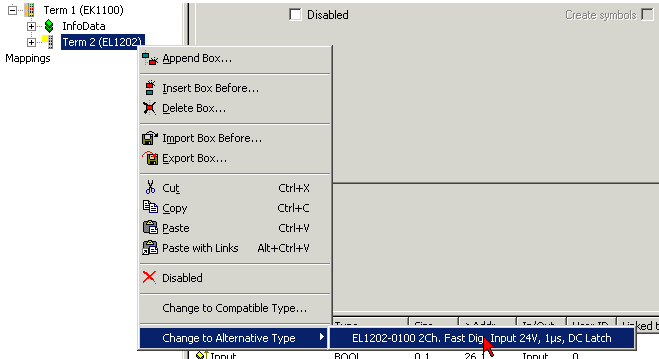Functioning
The EL1202 series currently offers two different operating modes:
EL1202-0000: fast 2-channel 24 V input terminal – the reading of the inputs is triggered by the communication frame (delivery state). No other settings can be made at the terminal.
EL1202-0100: fast, 2-channel, 24 V input terminal - reading the inputs is triggered in a highly stable cycle by the local DC (distributed clock), and can be configured.
The EL1202 is configured by Beckhoff ex stock as an EL1202-0000. The user must convert the terminal if operation as an EL1202-0100 is desired. This conversion is reversible.
Instruction for TwinCAT 2
Within TwinCAT 2 the EL1202(-0100) have to be selected in the configuration tree and “Change to Alternative Type” be chosen. This changes the EEPROM and thus the functionality of the EL1202 (Fig. Change to Alternative Type).
 Fig.137: Change to Alternative Type
Fig.137: Change to Alternative TypeInstruction for TwinCAT 3
Within TwinCAT 3 either the terminal in the configuration as the EEPROM of the terminal have to be reconfigured; the procedure as described for TwinCAT 2 is not possible.
- Within the configuration: add EL1202‑0100 as new device; delete the EL1202‑0000.
- Update EEPROM as described in chapter Firmware Update EL/ES/EM/EPxxxx.
 | Requirements for the master It is only possible to use the EL1202-0100 with EtherCAT masters (such as Beckhoff TwinCAT) that support distributed clocks (DC). In order to switch between the operating modes, the failure-safe configuration in the terminal must be changed (as from TwinCAT 2.10 Build 1316 this can be done on the terminal's “EtherCAT” tab). |
The absence of an input filter means that electrical pulses are not lengthened. In order to be recognized as TRUE or FALSE, an electrical signal must therefore be present at the evaluation unit at the time when it reads the input into its registers. This time depends on the version of the terminal and on the configuration that it has.